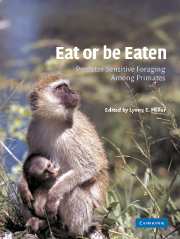Book contents
- Frontmatter
- Contents
- List of contributors
- Preface
- 1 An introduction to predator sensitive foraging
- PART I BIOLOGICAL VARIABLES
- PART II SOCIAL VARIABLES
- 6 The role of group size in predator sensitive foraging decisions for wedge-capped capuchin monkeys (Cebus olivaceus)
- 7 Group size effects on predation sensitive foraging in wild ring-tailed lemurs (Lemur catta)
- 8 Species differences in feeding in Milne Edward's sifakas (Propithecus diadema edwardsi), rufus lemurs (Eulemur fulvus rufus), and red-bellied lemurs (Eulemur rubiventer) in southern Madagascar: Implications for predator avoidance
- 9 Evidence of predator sensitive foraging and traveling in single- and mixed-species tamarin troops
- 10 Predator (in)sensitive foraging in sympatric female vervets (Cercopithecus aethiops) and patas monkeys (Erythrocebus patas): A test of ecological models of group dispersion
- 11 Predation risk and antipredator adaptations in whitefaced sakis, Pithecia pithecia
- PART III ENVIRONMENTAL VARIABLES
- Index
11 - Predation risk and antipredator adaptations in whitefaced sakis, Pithecia pithecia
Published online by Cambridge University Press: 10 November 2009
- Frontmatter
- Contents
- List of contributors
- Preface
- 1 An introduction to predator sensitive foraging
- PART I BIOLOGICAL VARIABLES
- PART II SOCIAL VARIABLES
- 6 The role of group size in predator sensitive foraging decisions for wedge-capped capuchin monkeys (Cebus olivaceus)
- 7 Group size effects on predation sensitive foraging in wild ring-tailed lemurs (Lemur catta)
- 8 Species differences in feeding in Milne Edward's sifakas (Propithecus diadema edwardsi), rufus lemurs (Eulemur fulvus rufus), and red-bellied lemurs (Eulemur rubiventer) in southern Madagascar: Implications for predator avoidance
- 9 Evidence of predator sensitive foraging and traveling in single- and mixed-species tamarin troops
- 10 Predator (in)sensitive foraging in sympatric female vervets (Cercopithecus aethiops) and patas monkeys (Erythrocebus patas): A test of ecological models of group dispersion
- 11 Predation risk and antipredator adaptations in whitefaced sakis, Pithecia pithecia
- PART III ENVIRONMENTAL VARIABLES
- Index
Summary
Introduction
The risk of predation poses a constant threat to the lives of primates living in natural habitats, and the study of its influence on many aspects of primate life has a long legacy in the history of primatology (Crook and Gartlan 1967, Eisenberg et al. 1972, Hart 2000, Kummer 1967, Terborgh 1983, Terborgh and Janson 1986). While these studies have been largely theoretical in nature, it seems clear that a number of different biological, ecological, and behavioral variables interact to constitute a given species' response to the threat of predation. Thus, for example, large body size may reduce the number of potential predators, a species may avoid areas where the density of predators (i.e., risk) is high, or small-bodied species may adopt a cryptic strategy in an effort to escape detection. Socially, individuals may give alarm calls to warn other members of the group in the event of danger, and/or manipulate their spatial proximity to other group members under different risk regimes (i.e., area or conditions of high vs. low risk, see Ydenberg 1998).
While problems exist in the interpretation of how these adaptations have evolved in concert with other social characteristics, it is difficult to imagine that the threat of being eaten represents anything but a strong selective force in the lives of nonhuman primates. Indeed, it is difficult to conceive of an ecological variable more closely related to individual fitness than the threat of death. However, predation is rarely observed directly, and this fact has led some to suggest that it may be of little consequence for the evolution of social structure (e.g., Cheney and Wrangham 1987).
- Type
- Chapter
- Information
- Eat or be EatenPredator Sensitive Foraging Among Primates, pp. 169 - 184Publisher: Cambridge University PressPrint publication year: 2002
- 9
- Cited by

